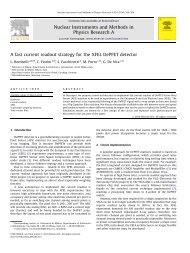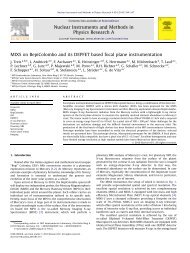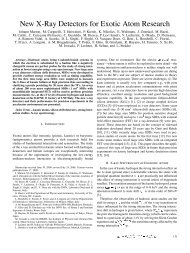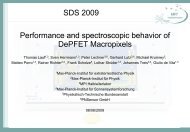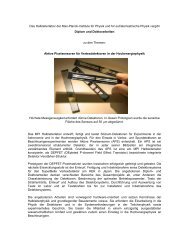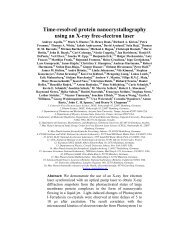X-ray imaging and spectroscopy with Controlled-Drift ... - MPG HLL
X-ray imaging and spectroscopy with Controlled-Drift ... - MPG HLL
X-ray imaging and spectroscopy with Controlled-Drift ... - MPG HLL
Create successful ePaper yourself
Turn your PDF publications into a flip-book with our unique Google optimized e-Paper software.
1<br />
X-<strong>ray</strong> <strong>imaging</strong> <strong>and</strong> <strong>spectroscopy</strong> <strong>with</strong> <strong>Controlled</strong>-<strong>Drift</strong> Detectors:<br />
experimental results <strong>and</strong> perspectives<br />
Andrea Castoldi, a* Antonio Galimberti, b Chiara Guazzoni, b Pavel Rehak, c Lothar<br />
Strüder, d<br />
a Politecnico di Milano, Dip. di Ingegneria Nucleare, CeSNEF, Piazza Leonardo da Vinci 32, 20133 Milano, Italy <strong>and</strong> INFN, Sez. di Milano<br />
b Politecnico di Milano, Dip. di Elettronica e Informazione, Piazza Leonardo da Vinci 32, 20133 Milano, Italy <strong>and</strong> INFN, Sez. di Milano<br />
c Brookhaven National Laboratory, Instrumentation Division, 11973 Upton, USA<br />
d Max Planck Institut Halbleiterlabor, Otto-Hahn-Ring 6, D-81739, Munich, Germany<br />
Abstract<br />
The <strong>Controlled</strong>-<strong>Drift</strong> Detector is a fully-depleted silicon detector that allows 2-D position sensing <strong>and</strong> energy <strong>spectroscopy</strong> of<br />
X-<strong>ray</strong>s in the range 1-30 keV <strong>with</strong> excellent time resolution. Its distinctive feature is the simultaneous readout of the charge<br />
packets stored in the detector by means of a uniform electrostatic field leading to readout times of few µs/cm. At frame rates<br />
higher than 60 kHz the achieved room-temperature energy resolution at the Mn Kα line is better than 300 eV FWHM thanks<br />
to the short integration time. In this paper we present the characterization of the <strong>imaging</strong> <strong>and</strong> timing properties of two CDD<br />
prototypes. Time resolved 2-D images in the microsecond range as well as X-<strong>ray</strong> radiographies will be presented. Details of<br />
the design of a new 6×6 mm 2 prototype will be presented <strong>and</strong> the preliminary measurements will be discussed.<br />
Keywords: Time resolved X-<strong>ray</strong> <strong>imaging</strong>; X-<strong>ray</strong> radiography; <strong>Controlled</strong>-<strong>Drift</strong> Detectors; Energy-resolved X-<strong>ray</strong> <strong>imaging</strong>;<br />
1. Introduction<br />
———<br />
* Corresponding author. Tel.: +39-02-2399-6321; fax: +39-02-2399-6309; e-mail: Andrea.Castoldi@polimi.it.
2<br />
The <strong>Controlled</strong>-<strong>Drift</strong> Detector [1] is a single<br />
photon counting 2-D X-<strong>ray</strong> imager proposed in 1997<br />
[2]. It is built on a fully depleted n-type highresistivity<br />
Silicon substrate <strong>with</strong> thickness in the<br />
range 300 – 500 µm. A lower resistivity layer<br />
electrons at about 10 µm from the detector front<br />
surface. In the normal operating condition the<br />
detector is switched between an integration phase <strong>and</strong><br />
a readout phase. During the integration phase a<br />
pixellated structure is generated in the detector<br />
2000<br />
FWHM = 12.7 ns<br />
∆t = 52 ns<br />
counts<br />
1000<br />
0<br />
#1 #2 #3 #4 #5 #6 #7 #8 #9 #10 #11<br />
60<br />
γ <strong>ray</strong><br />
59.5 keV<br />
energy [keV]<br />
40<br />
20<br />
γ <strong>ray</strong><br />
26.3 keV<br />
Np Lγ<br />
20.8 keV<br />
515 eV FWHM<br />
(56.8 el. r.m.s.)<br />
Np Lβ<br />
17.8 keV<br />
Np Lα<br />
13.9 keV<br />
0<br />
0.0 0.2 0.4 0.6<br />
drift time [µs]<br />
0 300 600<br />
counts<br />
Fig. 1. Scatter plot energy vs drift time of the X-<strong>ray</strong>s of a 241 Am source collected by a column of the CDD at 10 kHz frame frequency.<br />
The integration time was set to 90 µs <strong>and</strong> the readout time to 10 µs. The upper inset shows the distribution of the events along the time<br />
axis. The inset on the right end shows the total distribution of the event energies (i.e. the spectrum of the 241 Am source collected by all<br />
the pixels).<br />
epitaxially grown on or implanted in the Si substrate<br />
is employed as guiding layer to confine the signal<br />
volume by creating potential barriers in spite of a<br />
superposed electrostatic field pointing parallel to the
3<br />
wafer surface. During the drift phase an external<br />
control voltage removes the potential barriers<br />
preventing the electron drift so that the electrostatic<br />
field is free to transport the signal electrons to the<br />
readout electrode. The time between the start of the<br />
drift phase <strong>and</strong> the arrival of the signal electrons at<br />
the readout electrode gives the position of the<br />
irradiated pixel along the drift direction. The second<br />
coordinate is obtained providing a separate readout<br />
electrode for each pixel column. The amplitude of the<br />
charge packet collected at the readout electrode<br />
measures the energy of the incident X-<strong>ray</strong> <strong>with</strong><br />
spectroscopic resolution.<br />
The main performances of small area CDDs in<br />
terms of position <strong>and</strong> energy resolution have been<br />
extensively tested <strong>and</strong> are reported in [3-4]. The<br />
active area of this detector prototype is about 0.7 mm<br />
× 2 mm, corresponding to 4 × 11 pixels, 180 µm<br />
wide.<br />
Fig. 1 shows the scatter plot energy vs. drift time<br />
(i.e. position) of the events detected by a single<br />
column when the CDD is operated at 10 kHz frame<br />
frequency <strong>and</strong> exposed to a 241 Am radioactive source<br />
at room temperature. The detector was operated at<br />
such a low frame rate in order to collect enough<br />
statistics despite the low intensity of the radioactive<br />
source (100 µCi). Moving along the time axis we see<br />
that the events are gathered in well separated clusters<br />
corresponding to the characteristic lines of the 241 Am<br />
source (Np Lα, Lβ <strong>and</strong> Lγ lines can be clearly<br />
distinguished as well as the 26.3 keV <strong>and</strong> 59.5 keV γ-<br />
<strong>ray</strong>s) <strong>and</strong> to the illuminated pixels. The low intensity<br />
of the 59.5 keV γ-<strong>ray</strong> is due to the limited efficiency<br />
of the detector at high energy.<br />
The upper inset of Fig. 1 shows the distribution of<br />
the events along the time axis. The relative FWHM of<br />
the peaks is about 25% showing a margin for<br />
reduction of the pixel size along the drift coordinate.<br />
The inset on the right end of Fig. 1 shows the total<br />
distribution of the event energies (i.e. the spectrum of<br />
the 241Am source collected by all the pixels in the<br />
column). The energy resolution at the Np Lα line<br />
(13.9 keV) is 515 eV FWHM, corresponding to an<br />
Equivalent Noise Charge (ENC) of 56.8 electron<br />
r.m.s..<br />
When the detector is operated at the maximum<br />
frequency of 100 kHz, the achieved energy resolution<br />
at room temperature is 277.5 eV FWHM at the Mn<br />
m<br />
Kα line, thanks to the lower contribution of the<br />
leakage current integrated in the pixels [5]. These<br />
results show the feasibility of X-<strong>ray</strong> <strong>imaging</strong><br />
spectrometers based on CDDs <strong>and</strong> operated at or near<br />
room temperature giving energy resolutions close to<br />
state-of-the-art X-<strong>ray</strong> imagers operated at LN.<br />
In this paper we present the results of the<br />
characterisation of the <strong>imaging</strong> <strong>and</strong> timing properties<br />
of two CDD prototypes. The X-<strong>ray</strong> radiography of a<br />
wasp as well as the first time-resolved 2-D image in<br />
the microsecond range carried out <strong>with</strong> the small area<br />
CDD will be presented. The last section of the paper<br />
is devoted to the design <strong>and</strong> preliminary<br />
characterisation of a new generation of CDDs of<br />
larger area.<br />
2. X-<strong>ray</strong> radiography<br />
We have tested the <strong>imaging</strong> capabilities of the<br />
CDD by radiographing different objects <strong>with</strong><br />
synchrotron light in the range 8.5 keV – 30 keV [6].<br />
The CDD was operated at frame frequencies in the<br />
range 10 kHz – 100 kHz according to the transmitted<br />
intensity of the beam.<br />
Fig. 2 shows the radiography of a wasp. The<br />
detector was operated at 100 kHz frame frequency (9<br />
µs integration time <strong>and</strong> 1 µs drift time). The energy<br />
of the incident beam was set to 10 keV in order to<br />
optimise image contrast. Due to the small dimensions<br />
of the CDD prototype used in this measurement the<br />
1 cm<br />
Fig. 2. X-<strong>ray</strong> radiography of a wasp. The CDD was operated at<br />
100 kHz frame frequency <strong>and</strong> at 300 K. The energy of the<br />
incident beam was set to 10 keV.
4<br />
detector was panned to cover the entire object.<br />
Despite the relatively large dimensions of the pixel,<br />
significant details of the wasp body (e.g. antennas<br />
<strong>and</strong> legs) can be clearly distinguished.<br />
loudspeaker<br />
detector<br />
3. Time-resolved 2-D <strong>imaging</strong><br />
We tested the performances of the CDD in timeresolved<br />
2-D <strong>imaging</strong> in the sub-millisecond range.<br />
The experimental apparatus built for this purpose<br />
is shown in Fig. 3a. A 50 µm diameter pinhole has<br />
been fixed to a loudspeaker by means of a light arm.<br />
The system has been irradiated <strong>with</strong> a 650 nm DC<br />
laser. Fig. 3b shows two recorded images one <strong>with</strong><br />
the loudspeaker off <strong>and</strong> the other <strong>with</strong> the<br />
loudspeaker driven by a 106 Hz sinusoidal wave.<br />
This frequency was chosen to bring the system into<br />
resonance to obtain a larger displacement of the spot<br />
on the detector. When the loudspeaker is off we<br />
obtain the still image of the pinhole, having a<br />
diameter of the order of 250 µm on the detector.<br />
When the loud speaker is on, the acquired image<br />
shows that the achieved displacement of the laser<br />
spot is of the order of 1 mm.<br />
The detection system has been synchronised <strong>with</strong><br />
the input sine wave driving the loudspeaker. A time<br />
stamp for each image frame has been obtained by<br />
digitizing the input sine wave.<br />
A time resolution of 50 µs has been choosen to<br />
obtain time-sliced images. Fig. 4 shows one every ten<br />
time-sliced images to cover the full oscillation period.<br />
The sinusoidal-like displacement of the laser spot is<br />
beautifully reconstructed. By trading off between<br />
time resolution <strong>and</strong> statistics, time resolution can be<br />
improved down to 20 µs as the CDD was operated at<br />
50 kHz frame frequency.<br />
The capability of the CDD to perform time-<br />
laser source<br />
(650 nm)<br />
180µm<br />
OFF<br />
hν<br />
b)<br />
a)<br />
pinhole<br />
Ø 50 µm<br />
f=106 Hz<br />
~1mm<br />
Fig. 3. a) Experimental setup used for time–resolved <strong>imaging</strong> of a<br />
repetitive process. b) Image (540 µm × 1980 µm) of the pinhole<br />
mounted on the loud speaker <strong>with</strong>out any time slicing when the<br />
loud speaker is off <strong>and</strong> when the loud speaker is driven at 106 Hz.<br />
The CDD was operated at 50 kHz frame frequency.<br />
0 0.5 1 1.5 2 2.5 3 3.5 4 4.5 5 5.5 6 6.5 7 7.5 8 8.5 9ms<br />
Fig. 4. Time sliced images (50 µs) of the pinhole mounted on the loud speaker driven at 106 Hz. The sinusoidal-like diplacement of the<br />
pinhole is beautifully reconstructed.
5<br />
resolved X-<strong>ray</strong> images of repetitive processes <strong>with</strong><br />
sub-millisecond resolution can be of great interest in<br />
the industrial <strong>and</strong> medical fields [7]. In fact<br />
tomographic reconstructions can be performed by<br />
rapidly rotating the sample under test <strong>and</strong> keeping<br />
fixed the detector/source system. In this way also<br />
time dependent changes in the sample structure can<br />
be studied <strong>with</strong> the required time resolution. Detector<br />
frame frequencies higher than 10 kHz can be of<br />
interest also in time-resolved diffraction studies [8] in<br />
which the sample can be continuously rotated.<br />
4. Towards large area <strong>Controlled</strong>-<strong>Drift</strong> Detectors<br />
A second generation of <strong>Controlled</strong>-<strong>Drift</strong> Detectors<br />
has been designed <strong>and</strong> was recently produced at the<br />
Halbleiterlabor of the Max Planck Institut, München,<br />
Germany [9].<br />
The designed prototype, to be used as a<br />
demonstrator in <strong>imaging</strong> applications, has an active<br />
area of 6 mm × 6 mm. The pixel size (180 µm × 180<br />
µm) <strong>and</strong> the shape of the potential perturbation<br />
superposed to the linear bias of the field strips during<br />
the integration mode are the same of the previous<br />
prototype. The metalization mask of the designed<br />
detector is shown in Fig. 5. Several improvements<br />
Fig. 5. Metalization mask of the front side of the second<br />
generation 0.6 cm × 0.6 cm <strong>Controlled</strong>-<strong>Drift</strong> Detector.<br />
have been introduced <strong>with</strong> respect to the previous<br />
prototype. In order to improve electron transport<br />
during the drift mode, properly tailored deep n-<br />
implants have been added along the drift direction<br />
[10]. In order to reduce the risks of damage of the<br />
integrated dividers during the bonding of the detector,<br />
the bonding pads have been placed in a lateral area<br />
not overhanging the resistive implant of the dividers.<br />
The width of the guard regions is 1/6 of the drift<br />
length (in the previous prototype the ratio was 1/3).<br />
Preliminary tests of the electron transport over the<br />
6 mm drift length have been carried out by operating<br />
the CDD in continuous readout mode. An infrared<br />
pulsed laser (904 nm) has been focused on the front<br />
side of the detector in the middle of one drift channel<br />
to generate a signal charge of about 15,000 electrons.<br />
<strong>Drift</strong> fields from values as low as 25 V/cm up to<br />
400 V/cm have been tested. In all these cases the<br />
potential minimum was located at about 8 µm from<br />
the front surface <strong>with</strong>in the high-energy n-type<br />
implanted layer. A pseudo-gaussian shaping <strong>with</strong><br />
250 ns time constant was used for the measurements.<br />
For drift fields of 50 V/cm or smaller a longer<br />
shaping time of 3 µs has been used. In fact as the drift<br />
time increases the electron cloud broadening becomes<br />
comparable to the shaping time (at 50 V/cm the<br />
contribution of thermal diffusion to the electron cloud<br />
broadening is larger than 500 ns r.m.s.). The laser<br />
spot was displaced by 30 µm steps (equal to the pitch<br />
of the field strips) along the drift direction. Fig. 6<br />
shows the drift time as a function of the drift<br />
coordinate <strong>with</strong> the CDD biased at 300 V/cm. The<br />
measured non linearity error is below 40 ns <strong>and</strong> is<br />
mostly due to an accidental damage in the integrated<br />
divider at about 1/3 of the active area.<br />
Fig. 7 shows the average drift velocity as a<br />
function of the applied drift field. It has been derived<br />
from the linear fit of the measured drift times versus<br />
the drift coordinate. At 300 V/cm the average drift<br />
velocity is 0.35 cm/µs. Proper electron drift is<br />
possible even at 25 V/cm <strong>and</strong> the achieved average<br />
drift velocity is 0.026 cm/µs. The solid line shows the<br />
ideal bulk velocity v drift = µ n × E drift where we<br />
arbitrarily assumed µ n = 1400 cm 2 /(Vs) for the<br />
electron bulk mobility. The average drift velocity<br />
shows a reduction of about 17% <strong>with</strong> respect to the<br />
ideal drift velocity.
6<br />
2.0<br />
40<br />
1.2<br />
Tdrift [µs]<br />
1.5<br />
1.0<br />
0.5<br />
20<br />
0<br />
-20<br />
deviation from linear fit [ns]<br />
normalised amplitude<br />
0.8<br />
0.4<br />
0.0<br />
0 2000 4000 6000<br />
y, drift coordinate [µm]<br />
Fig. 6. <strong>Drift</strong> time vs. drift coordinate measured at 300 V/cm in<br />
continuous readout mode using a focused pulsed laser beam.<br />
The non-linearity visible at 1/3 of the drift length is due to a<br />
damage in the integrated voltage divider<br />
In order to verify the effectiveness of the<br />
combination of deep n- <strong>and</strong> p-implants in achieving<br />
the lateral confinement of the signal charge the laser<br />
spot was focused in the middle of a drift strip at about<br />
6 mm far away from the collecting electrode <strong>and</strong><br />
displaced by 5 µm steps along the lateral coordinate.<br />
The corresponding amplitude at the output electrode<br />
was measured. As shown in Fig. 8 for three neighbor<br />
channels, the deep implanted doping profile<br />
effectively confines the signal charge <strong>with</strong>in one drift<br />
channel.<br />
V drift [cm/µs]<br />
0.6<br />
0.4<br />
0.2<br />
0.0<br />
0 100 200 300 400<br />
E drift [V/cm]<br />
Fig. 7. Average drift velocity as a function of the applied drift<br />
field E drift . As a reference, the nominal drift velocity<br />
vdrift = µ n ⋅Edrift<br />
<strong>with</strong> µ n = 1400 cm 2 /(Vs) is shown as a<br />
solid line.<br />
-40<br />
Finally we biased the detector in integrate-readout<br />
mode at a drift field of 200 V/cm <strong>and</strong> repeated the<br />
measurement shown in Fig. 6. Fig. 9 shows the<br />
expected ‘staircase’ dependence of the drift time vs.<br />
the drift coordinate as <strong>with</strong>in the same pixel length<br />
the signal charge starts drifting from the same<br />
integration minimum. The nearly abrupt change of<br />
the measured drift time occurs when the laser spot<br />
crosses the saddle point defining the border between<br />
adjacent pixels of the same column.<br />
The same measurement was repeated for drift<br />
fields in the range 150 V/cm – 300 V/cm. In Fig. 10<br />
the measured drift time normalised to the drift time<br />
Tdrift [µs]<br />
3<br />
2<br />
1<br />
0.0<br />
0<br />
0<br />
-200 0 200<br />
lateral coordinate [µm]<br />
Fig. 8. Normalized amplitude as a function of the lateral<br />
coordinate at about 6 mm from the collecting electrodes.<br />
Three adjacent channels are shown.<br />
-2000<br />
-4000<br />
y, drift coordinate [µm]<br />
-6000<br />
Fig. 9: <strong>Drift</strong> time vs. drift coordinate at 200 V/cm when the<br />
CDD is operated in integrate-readout mode.
7<br />
normalised drift time<br />
1.2<br />
0.8<br />
0.4<br />
0.0<br />
0<br />
150 V/cm<br />
200 V/cm<br />
250 V/cm<br />
300 V/cm<br />
Fig. 10: <strong>Drift</strong> time vs. drift coordinate for drift fields in the<br />
range 150-300V/cm. Measured drift times are normalised to<br />
the drift time from the last pixel.<br />
from the last pixel is shown as a function of the drift<br />
coordinate. For all experimented drift fields the nonlinearity<br />
of the drift time vs. incident position is<br />
negligible compared to the pixel length apart from a<br />
small region around the already mentioned damage.<br />
Acknowledgement<br />
-2000<br />
-4000<br />
y, drift coordinate [µm]<br />
-6000<br />
This work was supported by INFN, Istituto<br />
Nazionale di Fisica Nucleare – Sezione di Milano, by<br />
the Italian Space Agency (ASI) <strong>and</strong> by the US<br />
Department of Energy under contract number DE-<br />
AC02-98CH10886. Accordingly, the U.S.<br />
Government retains a non-exclusive, royalty free<br />
license to publish or reproduce the published form of<br />
this contribution, or allow others to do so, for U.S.<br />
Government purposes.<br />
The authors gratefully acknowledge E. Gatti for<br />
many fruitful discussions <strong>and</strong> P. Holl <strong>and</strong> the staff of<br />
the MPI Halbleiterlabor for the detector production.<br />
We are specially indebted to S. Masci for careful<br />
bonding of the detector chip. We also acknowledge<br />
RTM of Vico Canavese (Italy) for the laser drilling of<br />
the chip holder. A. Castoldi, A. Galimberti <strong>and</strong> C.<br />
Guazzoni would like to thank R. Menk <strong>and</strong> F. Arfelli<br />
for the kind hospitality at the SYRMEP beamline<br />
(Sincrotrone Trieste).<br />
References<br />
[1] EP0862226. US Patent: US 6,249,033<br />
[2] A. Castoldi, C. Guazzoni, A. Longoni, E. Gatti, P. Rehak, L.<br />
Strüder, IEEE Trans. Nucl. Sci. 44 (1997) 1724.<br />
[3] A. Castoldi, E. Gatti, C. Guazzoni, A. Longoni, P. Rehak, L.<br />
Strüder, Nucl. Instr. Meth. A439 (2000) 519.<br />
[4] A. Castoldi, C. Guazzoni, P. Rehak, L. Strüder, IEEE Trans.<br />
Nucl. Sci. 48 (2001) 982.<br />
[5] A. Castoldi, G. Cattaneo, A. Galimberti, C.Guazzoni,<br />
P.Rehak, L.Strüder, IEEE Trans. Nucl. Sci. 49 (2002).<br />
[6] A. Castoldi, A.Galimberti, C. Guazzoni, P. Rehak, L. Strüder,<br />
R.Menk, submitted to Nucl. Instr. Meth. 2002.<br />
[7] A.Sarvestani et al., Nucl. Instr. Meth. A465 (2001) 354.<br />
[8] S.M. Gruner, Science 238 (1987) 305.<br />
[9] Max Planck Institut Halbleiterlabor, Otto-Hahn-Ring 6, D-<br />
81739, Munich, Germany. http:\\www.hll.mpg.de<br />
[10] A. Castoldi, C.Guazzoni, L.Strüder, IEEE Trans. Nucl. Sci. 49<br />
(2002).



